Culture of Slovakia
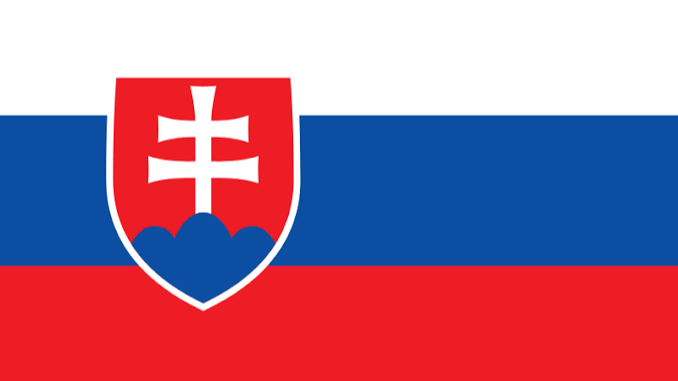
Culture Name
Slovak
Orientation
Identification. "Slovak" is derived from the Slovakian term for Slav: Slovan . There are three main regional culture areas: western, central, and eastern. Slovensko is the shortened local name for Slovakia, or the Slovak Republic. Slovaks share a common culture despite regional and even local differences in dialect, local customs, and religion. Hungarians (Magyars) in Slovakia are generally bilingual and have been acculturated but wish to maintain their national culture, especially their language.
Location and Geography. Slovakia (the Slovak Republic) is a landlocked country with ports on the Danube River at Bratislava and Komarno; it is bordered by the Czech Republic, Poland, Ukraine, Hungary, and Austria. Slovakia has a total area of 18,928 square miles (49,035 square kilometers). Its range of elevation runs from a low of 308 feet (94 meters) at the Bodrok River to a high of 8,711 feet (2,655 meters) at Gerlachovsky peak in the High Tatras. Slovakia's topography is extremely varied for such a small total area. Physiographic provinces range from the High Tatras in the north to the rich agricultural lands of the plains and the Danube Basin to the south. Other components of the Carpathian Mountains are the Little Carpathians and White Carpathians of western Slovakia and the Low Tatras and Slovak Ore Mountains in the north-central area. Bratislava, the capital, is a city of 441,453 population on the Danube in southwestern Slovakia. It appears on older maps as Pressburg and was once the Hungarian capital.
Demography. The July 1999 population estimate was 5,396,193, approximately 85.7 percent of which is ethnically Slovak. Hungarians are the largest cultural minority at 10.7 percent (nearly six hundred thousand) and are concentrated in the southern lowlands near the Hungarian border. Rom or Roma (Gypsies) account for 1.5 percent and probably are underreported in census figures, although there has been a substantial migration to Austria, the Czech Republic, and other nations since 1989. Rom occasionally self-identify as Hungarian in census records. Other groups include Czechs, 1.4 percent; Ruthenians (Rusyns), 0.3 percent; Ukrainians, 0.3 percent; Germans, 0.1 percent; and Poles, 0.1 percent. Rusyns are eastern Slavs who live in Slovakia, Ukraine, and Poland. The population growth rate is estimated to be 0.08 percent (1998), with an age structure of 0-14 years, 21 percent; 15-64 years, 68 percent; and 65 and over, 11 percent.
Linguistic Affiliation. Slovak, the national language, uses the Roman alphabet. Along with Czech and Polish, it is classified as a western Slavic tongue in the Indo-European language family. Slovak is very closely related to Czech. Political circumstances beginning nearly a thousand years ago separated populations, but Slovak and Czech are still mutually intelligible. There are three main dialects of Slovak, corresponding to the western, central, and eastern regions. It is said that the pronunciation of particular sounds in the western region is hard, while the dialect of central Slovakia is said to be softer sounding and was adopted historically as the norm. In all but parts of eastern Slovakia, the stress is on the first syllable of a word; longer words (three or more syllables) have secondary accents. There are Slovak words that appear to be formed entirely or mostly of consonants, such as the term for death: smrt' .
Slovak was designated the official language by the Slovak State Language Law of 1 January 1996. This measure curtailed the use of minority languages in the public sphere and mostly affected the Hungarian minority. The language law has now been revised and is less restrictive. Many Slovaks
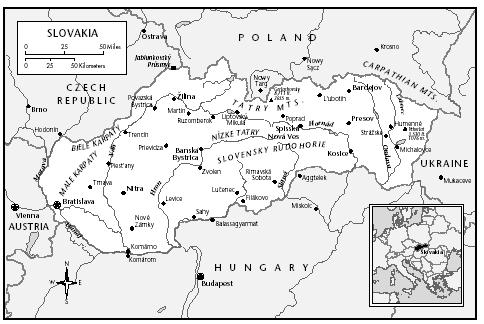
Slovakia
and most non-Slovaks know a second language. Besides Magyar (spoken by Hungarians) and Rusyn (spoken by Rusyns in eastern Slovakia), German, English, Russian, French, and Czech are used.
Symbolism. Slovakia's national flag consists of three equal horizontal bands of color, from top to bottom white, blue, and red. Superimposed over the bands on the left (hoist) side is a shield displaying the national emblem: a double apostolic cross in white sits atop the middle peak of three blue mountaintops, all on a red background. The emblem predates the national flag by centuries (elements of the emblem were used in the Great Moravian Empire) and appears in many contexts both in Slovakia and abroad among people of Slovak descent. The national flag became official on 1 January 1993, Independence Day. The national anthem, Nad Tatrou Sa Blýska , translates as "Lightning over the Tatras." The lyrics refer to stormy times and the belief that Slovaks survive them, while their oppressors and opponents lose. In the former Czechoslovakia, the Slovak anthem was played after the Czech anthem. Folk culture has had a broad impact on the symbols and metaphors of national culture. For example, the fujara , or shepherd's flute, a bassoonlike tube of wood over a meter long, and the valaška , or shepherd's ax, are markers of Slovak culture, along with folk costumes and designs.
History and Ethnic Relations
Emergence of the Nation. Slovaks trace their origins to the Slavic peoples who migrated from the European-Asian frontier to the area between the Danube and the Carpathians in the fifth and sixth centuries C.E. As increasingly sophisticated agricultural peoples, those Slavs established permanent communities in the Morava, Ipel', Torysa, Vah, and Nitra river valleys. This region of early western Slavic occupation, especially east of the Morava River, correlates almost exactly with the historical and contemporary geographic distribution of Slovaks. The settlement of Nitra became an early focus of political importance and the home of western Slavic rulers, such as King Svätopluk (870–894 C.E. ). The first Christian church in east-central Europe was established at Nitra, and in the ninth century, the Great Moravian Empire reached its greatest development, occupying all the land currently within Slovakia. The empire's estimated one million inhabitants included all the western Slavs (peoples who became the Czechs, Moravians, Slovaks, and Poles).
After the invasion of nomadic Hungarian peoples in the tenth century, the peoples who became the Slovaks were isolated from other western Slavic groups as a result of the conquest of the Great Moravian Empire after the Battle of Bratislava in 907. Hungarian rule over Slovaks lasted a thousand years until the end of World War I and the breakup of the Austro-Hungarian Empire. Halfway into that millennium, the Turks invaded this region.
The emergence of Slovak national consciousness is fairly recent, dating to about the 1700s, and has been punctuated by nationalistic movements, especially as the originally multiethnic Hungarian state attempted to transform itself into an ethnic Magyar state through programs of assimilation. Written Slovak appeared before the eighteenth century in literary texts, and near the end of that century a national movement began to delineate Slovak ethnic identity, especially in the work of Anton Bernolák, who codified written Slovak based on the western Slovak dialect. In the nineteenth century, this process continued with Ján Kollár and Pavol šafárik, who developed a written form of Slovak that combined the western and central dialects. L'udovit štu`r finally codified written Slovak by 1844, basing it on the central dialect. štu`r also encouraged the development of Slovak romanticism, with its focus on patriotism and nationalism and identification with popular and folk traditions. The formation of the Austro-Hungarian state in 1867 led to increased efforts to assimilate the Slovaks under Magyarization. Matica Slovenská , the Slovak cultural organization known in English as the Slovak Institute of Sciences and Arts, founded in 1863, was suppressed by 1875. Slovak secondary schools were closed. Compulsory language training in Hungarian was forced on Slovak children, and Hungarian became the official language. As the state grew more alien to Slovaks, they responded with increased tenacity in retaining their language and customs and emphasizing their ethnic identity through literature, music, and folk traditions. At the end of World War I, Slovak identity was fully formed, and in 1919 Slovakia joined with Czechia to form union of two western Slavic nations: Czecho-Slovakia. Slovakia became an independent nation on 1 January 1993.
National Identity. Slovak national culture and identity crystallized between about 1700 and World War I, in part as a reaction to centuries of attempted assimilation by other peoples, primarily Hungarians. Slovaks who emigrated to the United States in the last quarter of the nineteenth and the first quarter of the twentieth centuries promoted elements of national identity abroad.
Ethnic Relations. Slovaks have experienced adversarial relationships with four major ethnic groups as a consequence of wars, conquests, and political configurations: Hungarians, Czechs, Germans, and Russians. Nomadic Hungarian peoples conquered the ancestors of the Slovaks in 907 C.E. and retained control over them until the end of World War I. While closely related to Czechs culturally, Slovaks generally felt marginalized in the various permutations of the unified or federated Czecho-Slovakia and Czechoslovakia from 1919 to the end of 1992. This nonviolent ethnic conflict, sometimes called the "Slovak Question," ended in the recent "Velvet Divorce."
During the regime of Jozef Tito and the formation of a pro-Nazi state between 1939 and the end of World War II, Czech domination was replaced by German control. After 1948, Russian influence appeared with the re-creation of the Czechoslovak state and the establishment of the Warsaw Pact. Russian military personnel and Soviet armaments and aircraft were stationed in Slovakia after the 1968 Soviet-led invasion of Czechoslovakia by Warsaw Pact troops, during which the Prague Spring movement, led by Prime Minister Alexander Dubček (a Slovak), was crushed.
Currently, the most significant ethnic conflicts are with Hungarians and Rom. The large Hungarian minority concentrated in the lowlands of southern Slovakia has been more vocal and politically unified since 1989. In 1996, when the Slovak State Language Law took effect, Hungarian communities were further galvanized against the nationalistic government of Prime Minister Vladimir Mečiar. This led Hungarian political parties to join with the Slovak opposition to gain the majority in the fall 1998 parliamentary elections. Meanwhile, the Slovak and Hungarian governments have been at odds over the partially completed Gabčikovo-Nagmoros dam project on the Danube, a dispute that went to the World Court. Hungarians have long protested the project, mostly on the grounds that it poses a flood threat to Budapest and other Hungarian communities.
Rom have been physically attacked and even killed by ethnic Slovak skinheads in the past few years. While skinhead groups are relatively rare, racist attitudes toward the Rom persist among many Slovaks.
Urbanism, Architecture, and the Use of Space
The Slovak settlement pattern includes hamlets or colonies, villages, towns, and cities. They are distinguished by population size (with hamlets differing in both size and composition). Cities typically have populations over ten thousand, towns have between four thousand and about ten thousand people, villages have a few hundred to three thousand people, and hamlets or colonies have a few households with perhaps several dozen related people. Hamlets are rapidly depopulating in some areas, and many have ceased to exist; empty houses in others are being purchased by city dwellers for use as vacation homes.
Historically, ethnic Slovak dwellings consisted of one room where all activities took place: sleeping, food preparation and eating, and social and economic tasks. Over time, an additional room was added primarily for sleeping and entertaining. Furniture for sitting (long, narrow benches in older-style kitchens) and sleeping is placed along the walls, while tables for entertaining or providing work surfaces are moved near the benches in kitchens or remain in the center of the second room–bedroom. Family photographs and hand-painted ceramics adorn the walls of most rooms. Two-room houses of the older type can still be found in hamlets and villages. Occasionally rooms were added to accommodate newly married sons. Since the 1950s, most dwellings have indoor plumbing, although outdoor privies can still be found even in homes with running water and flush toilets. Structures for housing livestock frequently are attached to dwellings but are separated by walls and have their own entrances. Other outbuildings may include a rabbit hutch, a barn, and a separate structure where a hog is kept and fattened. Traditional Slovak homes had a fence with a gate leading into the yard as the only entrance visible from the street. The house usually was situated lengthwise on the property, with the door opening onto the little courtyard, not the street (there was little frontage.) The street side usually featured a flower garden, and a vegetable garden was located in back of the courtyard. In towns and cities, dwellings became more diverse over time. Some cities now exhibit suburban sprawl with high-rise apartment building away from the old town centers. Some towns and cities have incorporated nearby villages, and so within the same urban center one can see modern hotels and restaurants in one sector and decades-old peasant cottages in another. Vegetable gardens continue to be popular even in towns as a source of fresh produce.
Non-Slovak influence in the architecture of towns and cities is widespread. In eastern Slovakia, there are Gothic buildings in Spiš and Levoča, while Renaissance structures can be seen in šariš. Baroque and rococo buildings can be found in Bratislava. There are castles and strongholds from before the Crusades. Elements of Slovak folk architecture include the wooden churches and wooden and log dwellings of northern and eastern Slovakia, along with the plastered-over mud-brick homes of western and central Slovakia. There are central places and parks in towns and cities with benches, and virtually all communities except for hamlets have soccer fields. Most monuments commemorate wars, battles, and military, political, and cultural heroes. The most noteworthy Slovak monument is Bradlo, the massive hilltop tribute to General Milan Rastislav štefánik (1880–1919) near Košariskáin western Slovakia. Stefanik, a hero of World War I, is a national icon, and his monument is the site of pilgrimages. The second most popular type of monument commemorates the Slovak National Uprising of 1944 against Germany in World War II.
Food and Economy
Food in Daily Life. Slovak food exhibits much regional variation, but generally is based on soups, stewed and boiled vegetables, stewed fruits, smoked meats (especially sausages), roasted meats, gruels, and dairy dishes. Sheep cheese with small dumplings, bryndzové halušky , is among the most typical Slovak dishes. Traditionally in peasant households, five meals would be taken: early in the morning upon rising ( raňajky ), a snack at about ten A.M. ( desiata ), the main meal of the day at noon ( obed ), another snack around four P.M. ( olovrant ), and supper in the evening after chores ( večera ). Tea with sugar is the most popular hot beverage. Bread is served with every meal, and hot soup is a fixture as the first course at the main noon meal, with meat dishes commonly served at that time as well. The evening meal is usually light and may include bread, cheese, and vegetables. Beer, wine, juices, and carbonated water or flavored sodas are served with most meals. The main distilled beverage is plum brandy ( slivovica ), and borovička (gin) is quite popular.
Food Customs at Ceremonial Occasions. Special foods are prepared for a number of religious holidays.
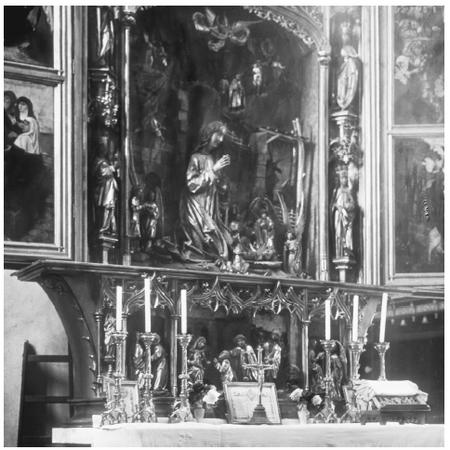
Religious sculptures stand on the side altar of the Church of Saint Egidius in Bardejov, Slovakia. Approximately three-quarters of the population is Christian.
On Christmas Eve, the meal is meatless and usually begins with a blessed wafer that is drizzled with honey. An alcoholic beverage based on honey called medové also is prepared for this occasion. A vegetable-based based soup is served first, followed by small baked pieces of dough that are moistened in milk and coated with a sweetened poppyseed mixture. On Christmas and other occasions for feasting, a roasted goose may be served, along with sausage ( klobása ). Fresh sausages ( jaternica , for example) made from barley, pork meat, blood, and rice also appear on special occasions. There is toasting with alcoholic beverages and a dessert of small cakes made with fruit or cheese fillings or log-shaped strudels with nut or poppyseed fillings. Salads tend to be made from sliced cucumbers prepared with a clear sweet and sour dressing or sour cream.
Basic Economy. Slovakia is an industrialized nation with a growing service sector. The economy was privatized amid accusations of racketeering in the 1990s. Many former collective farms have been transformed into agricultural cooperatives, with varying degrees of success. Earlier in the 1990s, some cooperatives were cash-poor and had to pay their workers with produce or livestock. The agricultural sector accounts for about 5 percent of the gross domestic product (GDP), industry contributes nearly 40 percent, and services account for around 55 percent. The labor force exceeds 2,300,000 and is divided (approximate percentages in 1994) as follows: services, 45.6 percent; industry, 29.3 percent; agriculture, 8.9 percent; transportation and communications, 8.2 percent; and construction, 8 percent. The unemployment rate, which was negligible before 1989 because of the structure of the command economy, has increased throughout the 1990s and is now nearly 20 percent (19.07 percent in June 2000). Unemployment is particularly high in areas that formerly produced armaments. Inflation was about 6 percent in 1997, and prices have been increasing for many goods and services.
Land Tenure and Property. Land, homes, and privatized businesses and factories can be owned by individuals, bought and sold, and passed on to heirs. Much agricultural land is owned and operated by members of cooperatives. Many Slovaks in rural areas retain ownership and exclusive use over plots of land that are used to generate food for family consumption or provide pasturage for livestock.
Commercial Activities. Agricultural production includes grains (rye, wheat, corn, barley), silage (clover), potatoes, sugar beets, hops, fruit, hogs, cattle, poultry, and wood products. There is growing travel and tourist industry, with hotels, restaurants, spas, car rental firms, and ski resorts. Privately owned retail stores now include some foreign investment.
Major Industries. Slovakia produces metal and metal products, fossil fuels (oil, gas, coke), chemicals, synthetic fibers, machinery, paper, ceramics, transportation vehicles, rubber products, optical and electrical apparatus, food and beverages, electricity, and nuclear fuel.
Trade. Slovakia's exports to major trading partners are as follows: Germany, 20.9 percent; Austria, 6 percent; other European Union countries, 14.4 percent; the Czech Republic, 30.6 percent; and countries of the former Soviet Union, 7.1 percent (1996). Exports totaled nearly $9 billion in 1996 and included machinery and transport equipment, chemicals, raw materials, and manufactured goods. Slovakia imports more than it exports. In 1996, it took in about $11 billion of imports in machinery and transport equipment, fuels, intermediate manufactured goods, and miscellaneous manufactured goods. Slovakia imports primarily from Germany, 14.7 percent; Italy, 6 percent; the Czech Republic, 24.8 percent; and countries of the former Soviet Union, 17.7 percent (1996 figures).
Social Stratification
Classes and Castes. Slovakia is characterized by socioeconomic classes, with the divisions falling along educational and occupational lines. However, income is not always an accurate indicator of class because some professions requiring advanced study have depressed pay scales.
Symbols of Social Stratification. Higher socioeconomic standing is marked by automobile ownership, stylish clothing, the size of a home or apartment, a home's furnishings and location, and even speech. People in lower socioeconomic groups take public transportation and are more likely to use regional dialects. A relatively small percentage of the population experienced great gains in wealth in the 1990s. An undocumented percentage of Slovaks receive financial help from relatives working in the West.
Political Life
Government. Slovakia is a parliamentary democracy with legislative, judicial, and executive branches. The legislative branch consists of a single-chamber parliament that meets in Bratislava, has one hundred fifty elected members, and is called the National Council of the Slovak Republic ( NR SR ). Members of parliament are elected for four-year terms through universal suffrage; the voting age is 18. The judicial system is represented by the Supreme Court (with judges elected by the parliament) and the Constitutional Court. Executive power is held by the prime minister and other ministers. After the general elections of 1998, Slovakia planned for the direct popular election of its president (the post was vacant after March 1998, when Michal Kovač, Slovakia's first president, left office).
Leadership and Political Officials. After the Velvet Revolution of 1989 in Czechoslovakia that ended communist rule, politicians who promoted national interests became popular in many areas of Slovakia. A charismatic leader named Vladimir Mečiar headed the Movement for a Democratic Slovakia and became prime minister. However, Slovaks
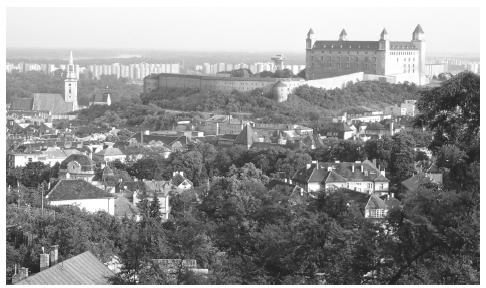
Bratislava Castle, a former palace, on a hilltop overlooking Slovakia's capital city, which is situated on the shores of the Danube River.
have become disenchanted with politicians as concerns over economic problems have grown. Many Slovaks blamed politicians for the Velvet Divorce that divided Czechoslovakia into two nations at the end of 1992. The 25–26 September 1998 Slovak elections produced a new governing coalition composed of former opposition parties, and Meciar was replaced by Mikulaš Dzurinda, chair of the Slovak Democratic Coalition (SDK). The agenda of the Dzurinda government includes the direct election of a president, membership in NATO, and admission to the European Union. In 1999, Rudolf Schuster (the chair of SOP, the Party of Civic Understanding) became the first directly elected Slovak president.
Current major political parties and movements include the Movement for a Democratic Slovakia (HZDS), Slovak Democratic Coalition (SDK), Slovak Workers' Association (ZRS), Christian Democratic Party (KDH), Democratic Union (DS), Slovak National Party (SNS), and Party of the Hungarian Coalition (SMK). In June 1998, there were upwards of twenty political parties and/or movements. On the local level, candidates for local office (mayor, vice mayor) are typically lifelong residents of their communities and are elected by popular vote.
Social Problems and Control. Slovak civil law is based on the former Austro-Hungarian codes of law, and its system has been modified to comply with the Organization on Security and Cooperation in Europe (OSCE). Property crimes became more common after 1989, and while most are committed by Slovaks, a steady influx of foreigners from Russia and other former Soviet bloc countries has contributed to the problem. Car theft, theft of merchandise, and burglary are much more common than they were before 1989. Pickpockets are active in urban areas and on buses and trains, assaults are more common, and there have been car bombings and political assassinations. Organized gangs of criminals have become powerful in some areas, and skinheads have committed assaults and other atrocities against Rom. Slovak law enforcement is understaffed. Informal social control is more likely to take place in villages where there is no resident police force and law enforcement must be called in from another town.
Military Activity. Before 1989, Slovakia was a major manufacturer of military equipment and a major arms-trading partner with the Soviet Union. That industry has been curtailed. The Czechs and Slovaks divided up military equipment when they split, with Slovakia receiving the smaller share. There is a military draft for males when they reach age 18; in 1998, it was estimated that total military manpower stood at 1,125,200. Military expenditures in 1998 totaled $436 million (U.S.), which represented 2.1 percent of GDP. The military branches are the army, the air and air defense forces, and the reserve force (home guards).
Nongovernmental Organizations and Other Associations
Nongovernmental organizations (NGOs) have proliferated since 1989 and number in the thousands. Slovak organizations and associations include trade unions, environmental and/or conservation groups, associations of artists and performers, folklore ensembles, political lobbying groups, and religious organizations. Examples are the Party of Entrepreneurs and Businessmen of Slovakia, the Christian Social Union, the Metal Workers Union (KOVO and METALURG), and the Confederation of Trade Unions (KOZ). There are also Slovak chapters of international organizations, including environmental groups such as the Greens.
Gender Roles and Statuses
Division of Labor by Gender. Until the second half of the twentieth century, political, medical (excluding nursing), religious, construction, architectural, engineering, managerial, and administrative roles were almost always restricted to men. Women could enter teaching, clerical positions, nursing, sales, and factory jobs. Change came about slowly, and today women are seen in most professions; there are female physicians, politicians, professors, managers, pastors, and administrators. However, in the household, women still are expected to perform child care and basic maintenance.
The Relative Status of Women and Men. Slovak men retain a privileged position in the home and the outside world. While women have been entering occupations traditionally held by men and more women are acquiring education beyond the secondary level and opting to remain unmarried longer, they still experience difficulties in certain areas, especially business and politics above the local level. Wealth remains largely in the hands of men.
Marriage, Family, and Kinship
Marriage. Slovaks practice monogamy, and individuals have free choice in the selection of marriage partners, though marrying within one's religion is
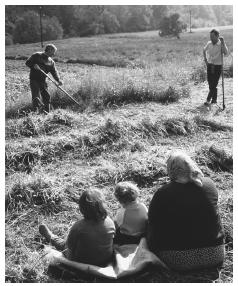
Men cutting grass in Ladomirova. Much agricultural land is owned and operated by cooperatives.
expected in many areas. In rural sectors, it was once expected that everyone would marry except individuals who were disabled. In modern Slovakia, people have other options, including remaining single and living with a partner. The majority of Slovaks marry and enjoy some economic benefit, especially if they have children. Parents still receive, in many instances, a cash bonus when a child is born and mothers are given ample maternity leave. Divorce has become common since the 1980s, along with remarriage. Gay and lesbian partnerships remain mostly closeted, and same-sex marriages are not legal.
Domestic Unit. The basic household unit has increasingly become the nuclear family. Traditional households, especially in rural areas, consisted of extended families that were three generations deep. Grandparents, particularly grandmothers, cared for the offspring of married sons or daughters. Slovaks were at one time more likely to live with the groom's family. Men retain authority in the household, though women informally negotiate decision making and exert considerable influence. Today both spouses are likely to work outside the home.
Inheritance. The children of a couple inherit property equally. In the past, a dowry system operated among the peasantry, and daughters who wanted to accumulate a dowry might sell their future share of property to their brothers for cash. As a result of land reallocations in the past, partible inheritance practices among landowners resulted in plots of dwindling size in only a few generations. The resulting ribbonlike strips of land could seldom support a family. Today, the grown children of deceased parents feud over shares in houses and property. If one of them already occupies the house, he or she may have to sell it to satisfy the claims of siblings.
Kin Groups. Rural-urban migration has resulted in a dispersing of kin, as has emigration to the West. Young people no longer expect to remain in the hamlets, villages, or towns of their birth but seek to move to cities. Today there are no kin groups larger than the extended family. Slovaks have bilateral kinship and trace descent through both parents.
Socialization
Infant Care. Slovaks place infants in cribs to sleep in the parents' bedroom. Babies play in little pens or in safely confined areas on a blanket on the floor. They are wheeled around outside in strollers but are picked up and carried in the home. Very active or crying babies are entertained and/or pacified with a variety of toys and teething objects.
Child Rearing and Education. Children are supposed to behave like miniature adults. They are expected to be quiet, attentive, and respectful and to keep their clothing clean. Parents and other care-givers attempt to set parameters of behavior and then assess sanctions when rules are broken. Corporal punishment is still common, although less violent methods are increasingly employed. Families try to instill a serious work ethic in children and may assign them substantive chores as early as age seven. In rural areas, once it was common for elementary school-age children to take geese and other small livestock to pasture. There is compulsory formal education for children through the tenth grade.
Higher Education. Slovaks value postsecondary education, and many parents encourage their children to prepare for it by attending academic high schools. However, there appear to be many more students eligible to attend universities than there are places for them.
Etiquette
Slovaks maintain a typically Western distance (about three feet) when conversing. Greetings are expected, and consist of "good morning," "good day," and "good evening." "Good night" is reserved for the last leave taking of the evening. Both men and women shake right hands with acquaintances and newly introduced strangers, and men and women may kiss close friends and relatives on both cheeks during greeting and leave taking. For business and other professional activities, men are expected to wear suits and ties, while women still adhere to a code that involves dresses or two-piece suits with skirts or skirts and blouses.
Lunches tend to be lengthy with several courses served because the noon meal is the main meal of the day. During a visit to a home, food and drink are immediately placed on the table. Refreshments are supposed to be accepted graciously, and emptied plates and glasses are refilled promptly. It is customary to bring flowers, food (cakes), or a beverage when visiting people's homes. Business lunches and home visits are likely to include the offer of alcoholic beverages. Women usually can refuse politely and request a soft drink or hot tea. Men are expected to drink but may decline if they are driving.
Religion
Religious Beliefs. The monks Cyril and Methodius brought Christianity to the Great Moravian Empire in the ninth century, but there is evidence of an earlier traditional religion among western Slavs that involved a pantheon of supernatural beings. Today, 70 to 75 percent of Slovaks are Christian, and the majority (60.3 percent) are Roman Catholics. This figure includes Rom, most of whom are Catholic. Other major religions include Evangelical Lutheran, nearly 7 percent; Orthodox Christian, 4.1 percent; and Judaism (greatly reduced by the Holocaust), around 1 percent). Atheists may constitute nearly 10 percent of the population, and other faiths (especially Christian) account for the rest.
Religious Practitioners. Full-time religious practitioners include priests, pastors, and rabbis. In many communities, religious leaders participate in secular events and celebrations alongside political officials. Political leaders no longer control their activities, as they did before 1989.
Rituals and Holy Places. Slovaks affiliated with the major religions worship in established churches or synagogues. Christians conduct burial rites in cemeteries, and some groups visit special sacred areas. The Roman Catholic Church of Saint Jacob in Levoča ranks as one of the most significant shrines. In eastern and parts of central Slovakia, Roman
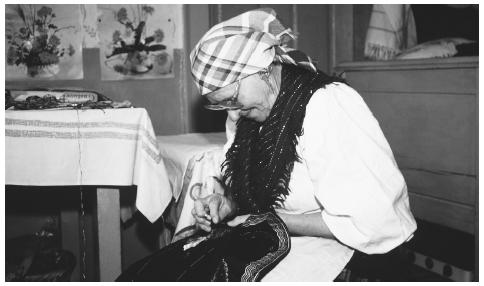
A Slovakian woman embroiders a piece of fabric. Slovakia has an extensive arts and crafts heritage.
Catholics place offerings of flowers and sometimes scarves at free-standing crosses in the countryside.
Death and the Afterlife. Slovak Christians believe that the soul survives death, and they bury their dead below ground in cemetery plots rather than cremating. In many villages, embalming was introduced as late as the 1980s, and wakes commonly were held at home before the widespread construction of houses of sorrow at or in cemeteries. In some communities, children from the same village are buried together in one or more rows of individual plots rather than with their families. Mourning lasts for nearly a year, and traditionally adult daughters and widows wear only black or subdued colors. Christian cemeteries tend to be located near churches, and it is common to see weeds and unmown grass there. Jewish cemeteries fell into neglect after the Holocaust. Many Christians in rural areas believed that ghosts of the deceased could come back and cause mischief; some people still attribute various types of misfortune to the activities of ghosts.
Medicine and Health Care
Slovaks used to attribute illness and misfortune to supernatural causes and sought curers to diagnose their problems and provide remedies. They made extensive use of medicinal plants and mud poultices. Linden ( lipa ) blossoms were collected and dried to make infusions for various maladies. Serious cuts could be treated with the sap of red milkweed, and a beverage brewed from the plant called mouse's tail reportedly lowered blood pressure. Numerous medicinal spas, such as Piešťany in western Slovakia, have attracted patients for centuries. Slovakia's spas enjoy international renown and tend to be associated with specific types of ailments.
In the 1970s, curers for diagnosing and treating the evil eye could be found in rural areas, but modern medicine is Western in character. Villages typically have clinics staffed by resident nurses and midwife-paramedics. Regular visits by nonresident dentists, pediatricians, general practitioners, and obstetrician-gynecologists before 1989 provided free health care for all citizens, with nominal charges for prescriptions. After 1989, socialized medicine ended and medical care moved toward privatization. In general, the cost of medical care and equipment is the responsibility of individuals.
Secular Celebrations
Slovaks celebrate a number of public holidays, several of which are associated with the Christian calendar and beliefs. January 1 is both New Year's Day
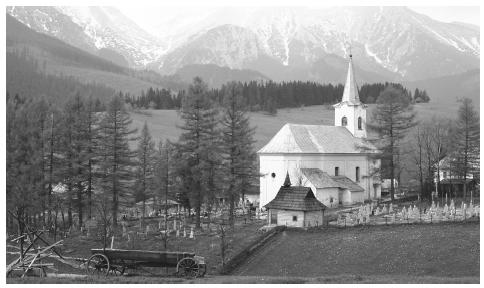
Mountains and trees surround a small white church and graveyard. Slovakia has extremely varied topography for its size; its elevation ranges from 308 feet (94 meters) to 8,722 feet (2,655 meters).
and Independence Day. January 6 is Epiphany, a Christian festival celebrated especially in Catholic communities, where boys dress up as the Magi and go in a procession from house to house. Other Christian spring holidays on the public calendar include Good Friday, Easter Sunday, and Easter Monday, when young men used to visit homes of single young women and switch them with whips made of willow branches tied with ribbon and douse them with cologne. May Day (1 May), a survival from a much older annual round of Slavic and Slovak festivals signifying the major spring celebration, was transformed during the decades of communism into a celebration of workers, with political speeches and shows of military force. The liberation of the Slovak Republic is commemorated on 8 May. Another Christian and national holiday (observed mostly by Catholics), 5 July, honors Saints Cyril and Methodius, who brought Christianity to the Slavs. The anniversary of the Slovak national uprising in World War II is celebrated on 29 August. Constitution Day of the new Slovak Republic is celebrated on 1 September, and 15 September marks another Christian holiday: Our Lady of the Seven Sorrows. All Souls' (Saints') Day on 1 November is observed by many Christians; visits are made to relatives' cemetery plots, where candles are lit. Christmas, the final holiday of the calendar year is celebrated on 25 December, and 31 December marks the celebration of Sylvester (New Year's Eve).
Annual local secular celebrations usually include an end-of-the-school-year festival and parade, and in agricultural areas there are events marking the end of the grain harvest. This festival is called dožinky and usually occurs in August. In the early fall, oberačky celebrates the harvesting of apples and other late orchard crops. These local secular events include feasting and dancing.
The Arts and Humanities
Support for the Arts. Folk arts and crafts have enjoyed government support through the Center for Folk Art Production (ULUV). The center has promoted these arts abroad through numerous exhibitions. However, in many areas, state subsidies for the arts dried up after 1989, and artists have had to find other means of support.
Literature. Slovak folklore has a long oral tradition of storytelling. Stories generally fall into two categories: folktales that have broad geographic distribution in Slovakia and stories that stem from personal accounts that may be told for only one or two generations in an individual family.
The formal written literary language arose in the eighteenth century and was codified in the nineteenth century. Poetry became established in the nineteenth and twentieth centuries as a vehicle of the national spirit. While male poets were prominent in the public sphere, the recent publication of Incipient Feminists: Women Writers in the Slovak National Revival by Norma Rudinsky has revealed poems written by women.
While books were affordable before 1989 because of government support, the communist regime controlled and monitored what was published. After 1989, state financial sponsorship of publishing entered a period of transition, resulting in price increases for most books.
Graphic Arts. Slovakia has an extensive heritage of arts and crafts. Modra in southwestern Slovakia has been a center for the production of fine ceramics that began in the 1600s and now exhibits a distinctive folk-art form incorporating historical designs and firing techniques. Painting, sculpture, wood carving, glass (crystal) making, and other graphic arts enjoyed a decade of expansion and access to new markets after 1989. There are stores operated by regional artists' associations where works are sold, and new outlets to Western markets have been established. Modern art has roots both in Slovak folk themes and in European art in general. Most graphic artists belong to special associations or organizations; there are galleries and shows in cities and towns and in many museums. Art exhibits appear occasionally in villages.
A particular type of graphic art involving wire and metalworking was produced by Slovak tinkers from the Upper Vah River Valley or Spis. Their production of utilitarian household items such as candleholders is considered an art form.
Performance Arts. Performance arts fall into three main categories: folk, formal and/or classical, and modern and contemporary. Folk performances are usually local events, many in rural areas, and most often are held in the summer. They frequently are associated with particular festival dates or special commemorative events, such as the first mention of a village in historical records. Folk music, folk dances, minidramas and musicals, and mock weddings with the participants dressed in traditional costumes remain popular. Some folk performances are national or even international in scope, such as the festival in Východná in July. Traditional music ranges from groups playing string instruments and clarinets to groups playing brass instruments. Slovak music is said to have been influenced by both liturgical and chamber music, but a national musical tradition arose in the first half of the nineteenth century that was based primarily on folk themes.
Formal and/or classical and modern and/or contemporary performances are numerous. There are orchestras and chamber groups in many cities, with the most significant groups having their primary homes in Bratislava. A chamber opera was founded in 1986 to provide an outlet for newer performers in a kind of alternative theater.
There are theaters throughout Slovakia where skits, plays, operas, and puppet shows are performed before enthusiastic audiences. Motion pictures have become important in Slovak performance art since the 1960s. While many restrictions were placed on films made before 1989 and those films were expected to promote a political agenda, some works achieved international renown, such as The Shop on Main Street . In the 1990s, because of a lack of state financing, the main film studio closed, but Slovak filmmakers have continued their work.
The State of the Physical and Social Sciences
The physical and social sciences are extremely active in Slovakia. Numerous scientific journals are published, and some now appear in electronic form online. Many institutions of higher learning offer courses of study leading to advanced degrees in natural, behavioral, and social sciences as well as engineering, environmental science, and agricultural engineering. Comenius University and Slovak Technical University, both in Bratislava, are leading institutions in the physical and social sciences. While higher education was free before 1989, there has been a transition to a tuition-based program. In recent years, students in the social sciences numbered about 15.5 percent of the total university population, while natural science accounted for 3 percent and engineering, architecture, mathematics, and other sciences together accounted for 37 percent. There are twenty-one state institutions of higher learning: eighteen civilian schools, two military academies, and one policy institute.
Bibliography
Baylis, Thomas A. "Elite Change after Communism: Eastern Germany, the Czech Republic, and Slovakia." East European Politics and Societies 12 (2): 265–299,1998.
Bugaski, J. Ethnic Politics in Eastern Europe: A Guide to Nationality Policies , 1995.
El Mallakh, Dorothea H. The Slovak Autonomy Movement, 1935–1939: A Study in Unrelenting Nationalism , 1979.
Erdmann, Yvonne. "The Development of Social Benefits and Social Policy in Poland, Hungary and the Slovak Republic since the System Transformation." East European Quarterly 32 (3): 301–314, 1998.
Fish, M. Steven. "The Determinants of Economic Reform in the Post-Communist World." East European Politics and Societies 12 (1): 31–78, 1998.
Jelinek, Yeshayahu, The Parish Republic: Hlinka's Slovak People's Party, 1939–1945 , 1976.
Johnson, Owen V., Slovakia 1918–1938: Education and the Making of a Nation , 1985.
Kirschbaum, Stanislav J., and Anne C. Roman, eds. Reflections on Slovak History , 1987.
Leff, Carol Skalnik. National Conflict in Czechoslovakia: The Making and Remaking of a State, 1918–1987 , 1988.
Mikus, Joseph A. Slovakia and the Slovaks , 1977.
Oddo, Gilbert. Slovakia and Its People , 1960.
Portal, Roger. The Slavs: A Cultural and Historical Survey of the Slavonic Peoples , 1969.
Pynsent, Robert B. "Tinkering with the Ferkos: A Kind of Slovakness." Slavonic and East European Review 76 (2): 279–295, 1998.
Rudinsky, Norma L. Incipient Feminists: Women Writers in the Slovak National Revival , 1991.
Seton-Watson, R. W. A History of the Czechs and Slovaks, 1943.
Stolarik, Marian Mark. Immigration and Urbanization: The Slovak Experience, 1870–1918 , 1989.
Teleki, Ilona. "Loss and Lack of Recognition: Identifying Fears in the Slovak-Hungarian Relationship." Slovo 10 (1–2): 199–218, 1998.
